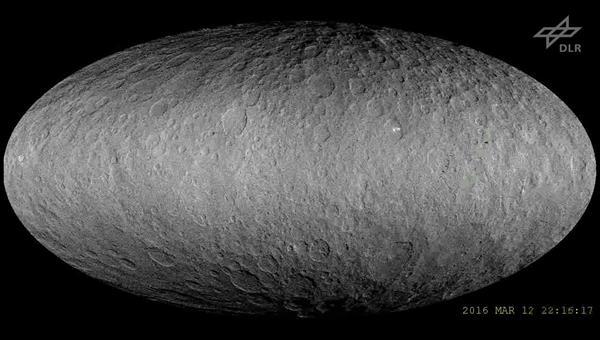Dwarf planet Ceres – mysterious material on craters and mountains


Your consent to the storage of data ('cookies') is required for the playback of this video on Quickchannel.com. You can view and change your current data storage settings at any time under privacy.
NASA/JPL-Caltech/UCLA/MPS/DLR/IDA/PSI

The dwarf planet Ceres is becoming an increasingly mysterious – and exciting – celestial body as the planetary researchers working on the Dawn mission acquire more and more details. The contrast-enhanced true colours show a bluish material around several craters and mountain slopes. "Initially, it would have been fair to assume that it was produced when the crater formed during impact, but we can also see the material on Ceres' highest mountain, Ahuna Mons," explains Ralf Jaumann from the German Aerospace Center (Deutsches Zentrum für Luft- und Raumfahrt; DLR). "Additionally, one could reasonably expect to see this blueish material in all craters." The researchers have not yet identified a precise explanation for this phenomenon. The Dawn team presented new images of the dwarf planet, acquired from an altitude of just 385 kilometres, at the 47th Lunar and Planetary Science Conference in Texas.
Layer for layer
The contrast-enhanced colour maps of the dwarf planet Ceres show that the blueish and relatively fresh material is found in more recent craters and clinging to the mountain slopes of Ahuna Mons. "This material represents flow structures and was most probably caused by an interaction between the direct surface and the material lying directly below." It follows, therefore, that beneath the ice-free surface of Ceres, there must be another, different layer. "There are indications that this layer, situated under the uppermost crust, is enriched with ice and volatile substances." In contrast, so far, barely any ice has been discovered on the surface, as it would immediately sublimate.
The data that the Dawn orbiter is now sending back to Earth from its lowest orbit has proven helpful in the attempts to solve this mystery. “Just last year, the Occator crater looked like a single bright expanse," explains Ralf Jaumann, DLR planetary researcher and member of the Dawn team. "Now, the close-up images allow us to recognise more complex structures." Besides puzzling bright spots on the inside of the crater, there is also an expansive, light-coloured bulge right in the centre alongside innumerable cracks and fractures. "These patterns indicate quite recent geological activity – but we have to finish mapping of deposits and determine the composition before we can test our theories concerning the formation of these complex structures."
The mission
The Dawn mission is managed by NASA's Jet Propulsion Laboratory (JPL) in Pasadena, which is a division of the California Institute of Technology. The University of California, Los Angeles, is responsible for overall Dawn mission science. The Framing Camera system on the spacecraft was developed and built under the leadership of the Max Planck Institute for Solar System Research in Göttingen, Germany, in collaboration with the DLR Institute of Planetary Research in Berlin and the Institute of Computer and Communication Network Engineering in Braunschweig. The Framing Camera project is funded by the Max Planck Society, DLR, and NASA/JPL.
